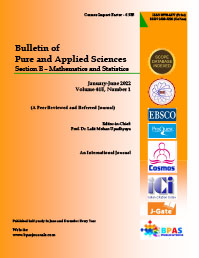Production inventory system for deteriorating items with trapezoidal type demand ∗
DOI:
https://doi.org/10.48165/Keywords:
Inventory system, EPQ model, Trapezoidal type demand, Deterioration, Minimizing Total CostAbstract
For the items like trendy goods, mobile phones and such others, it is examined that the demand rate is of trapezoidal type. The aim of this study is to present optimal production policy for deteriorating items, when the demand of an item is trapezoidal type. Rate of deterioration is assumed to be constant and rate of production depends upon demand rate. Shortages are not allowed. Mathematical formulation is derived in order to minimize the total cost of an inventory system. An easy to use algorithm is presented to decide an optimal production policy
References
Bakker, M., Riezebos, J. and Teunter, R.H. (2012). Review of inventory systems with deterioration since 2001, European Journal of Operation Research, 221, 275–284.
Chen, H.L., Ouyang, L.Y. and Teng, J.T. (2006). On an EOQ model with ramp type demand rate and time dependent deterioration rate, International Journal of Information and Management Sciences, 17(4) , 51–66.
Mihir S. Suthar, Kunal T. Shukla and Nikhilkumar D. Abhanghi
Cheng, M. and Wang, G. (2009). A note on the inventory model for deteriorating items with trapezoidal type demand rate, Computers and Industrial Engineering, 56, 1296–1300. [4] Cheng, M., Zhang, B. and Wang, G. (2011). Optimal policy for deteriorating items with trapezoidal type demand and partial backlogging, Applied Mathematical Modeling, 35, 3552–3560. [5] Covert, R.P. and Philip, G.C. (1973). An EOQ model for items with Weibull distribution deteri oration. AIIE Transactions, 5, 323–326.
Dave, U. and Patel, L.K. (1981). (T, Si) policy inventory model for deteriorating items with time proportional demand, The Journal of the Operational Research Society, 32, 137–142. [7] Deng, P.S. (2005). Improved inventory models with ramp type demand and Weibull deterioration, International Journal of Information and Management Sciences, 16(4), 79–86. [8] Deng, P.S., Lin, R.H.J. and Chu, P. (2007). A note on the inventory models for deteriorating items with ramp type demand rate, European Journal of Operational Research, 178(1), 112–120. [9] Donaldson, W.A. (1977). Inventory replenishment policy for a linear trend in demand: an analytic solution, Operational Research Quarterly, 28, 663–670.
Ghare, P.M. and Schrader, G.F. (1963). A model for exponentially decaying inventories, Journal of Industrial Engineering, 14, 238–243.
Giri, B.C., Jalan, A.K. and Chaudhuri, K.S. (2003). Economic order quantity model with Weibull deterioration distribution, shortage and ramp-type demand, International Journal of Systems Science, 34(4), 237–243.
Goyal, S.K. and Giri, B.C. (2001). Recent trends in modeling of deteriorating inventory, J. Euro pean Journal of Operation Research, 134 (1), 1–16.
Goyal, S.K. (1986). On improving replenishment policies for linear trend in demand, Engineering Costs and Production Economics, 10, 73–76.
He, Y., Wang, S.Y. and Lai, K.K. (2010). An optimal production-inventory model for deteriorating items with multiple-market demand, European Journal of Operational Research, 203(3), 593–600. [15] Hill, R.M. (1995). Inventory model for increasing demand followed by level demand, The Journal of the Operational Research Society, 46, 1250–1259.
Manna, P., Manna, S. and Giri, B.C. (2016). An economic order quantity model with ramp type demand rate, constant deterioration rate and unit production cost, Yugoslav Journal of Operation Research, 26 (3), 305–316.
Manna, S.K. and Chaudhuri, K.S. (2006). An EOQ model with ramp type demand rate, time dependent deterioration rate, unit production cost and shortages, European Journal of Operational Research, 171(2), 557–566.
Raafat, F. (1991). Survey of literature on continuously deteriorating inventory model, The Journal of the Operational Research Society, 42, 27–37.
Resh, M., Friedman, M. and Barbosa, L.C. (1976). On a general solution of the deterministic lot size problem with time-proportional demand, Operations Research, 24, 718–725. [20] Ruxian, L., Hongjie, L. and Mawhinney, J.R. (2010). A review on deteriorating inventory study. Journal of Service Science and Management, 3, 117–129.
Shah, N.H. and Shah, Y.K. (2000). Literature survey on inventory models for deteriorating items. Ekonomskianali, 44 (145), 221–237.
Shukla, K.T. and Suthar, M.S. (2016). A framework for an inventory model for deteriorating items with expiration under trapezoidal type demand and partial backlogging, Logforum, 12(2), 269–281.
Skouri, K., Konstantaras, I., Manna, S.K. and Chaudhuri, K.S. (2011). Inventory models with ramp type demand rate, time dependent deterioration rate, unit production cost and shortages, Annals of Operations Research, 191(1), 73–95.
Skouri, K., Konstantaras, I., Papachristos, S. and Ganas, I. (2009). Inventory models with ramp type demand rate, partial backlogging and Weibull deterioration rate, European Journal of Oper ational Research, 192(1), 79–92.
Production inventory system ... 549
Vandana and Shrivastava, H.M. (2017). An inventory model for ameliorating / deteriorating items with trapezoidal type demand and complete backlogging under inflation and time discounting, Mathematical Methods in the Applied Sciences, 40(8), 2980–2993.
Wu, K.S. (2001). An EOQ inventory model for items with Weibull distribution deterioration, ramp type demand rate and partial backlogging, Production Planning and Control, 12, 787–793. [27] Wu, K.S. and Ouyang, L.Y. (2000). A replenishment policy for deteriorating items with ramp type demand rate, Proceedings of the National Science Council, Republic of China (A), 24, 279-286. [28] Wu, J.W., Lin, C., Tan, B. and Lee, W.C. (1999). An EOQ model with ramp type demand rate for items with Weibull deterioration, International Journal of Information and Management Sciences, 10, 41–51.
Wu, K.S., Ouyang, L.Y. and Yang, C.T. (2008). Retailers optimal ordering policy for deteriorating items with ramp-type demand under stock-dependent consumption rate, International Journal of Information and Management Sciences, 19(2), 245–262.
Wu, J., Skouri, K., Teng, J.T. and Hu, Y. (2016). Two inventory systems with trapezoidal type demand rate and time dependent deterioration and backlogging, Expert Systems with Applications, 46, 367–379.
Wu. J., Teng, J.T. and Skouri, K. (2018). Optimal inventory policies for deteriorating items with trapezoidal type demand patterns and maximum life times under upstream and downstream trade credits, Annals of Operation Research, 264(1), 459–476.
